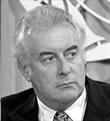J ) A US THA1
PRIME MINISTER PRESS STATEMENT NO. 520
June 1975
EMBARGO: 6 p. m.
JOINT PRESS STATEMENT BY THE PRIME MINISTER AND THE
PREMIER OF TASMANIA
The Prime Minister' ( Mr Whitlan) and the Premier of
Tasmania ( Mr Neilson) announced their general agreement
with the recommendations of the Joint Expert Advisory
Committee on the second Derwent River crossing at Hobart.
They also announced that an immediate start would
be made on detailed investigation and design for a second
bridge and road approaches at Dowsings Point. The bridge,
to be of concrete box construction, would be designed to be
compatible with the attractive natural environment in
the vicinity of Dowsing Point. It would carry four
traffic lanes and, with approaches, is estimated to cost
$ 21 million. Detailed investigation and design of the second
bridge would be carried out under the auspices of a new
Joint Committee to be constituted by the two Goverments.
When firm information becomes available as a result of these
studies, an environmental impact statement will be prepared.
The statement will incorporate details of the studies
already undertaken on alternative locations and give due
regard to the location and design of the proposed bridge,
the changes to the metropolitan road systems and consequential
effects of land use on both banks of the Derwent.
Mr Whitlam, and Mr Neilson said that the-. two Governments
would have discussions on the timing for construction of the
new bridge, procedures for the further studies and their
assessment and the financial arrangements involved.
It was expected that investigations and design and
preparation of contract documents would take about 18 months.
The timing of actual construction would need to be keyed to
completion of reconstruction of the Tasman Bridge. / 2
Mr Whitlam gave an undertaking that the Bridge and
associated roadwords would be funded by the Australian
Government up to the cost applicable to a bridge of
metres vertical clearance.
Mr Neilson said that he and Mr Whitlam had discussed
the question of land use involved in areas made more
accessible by the second crossing. He had given the
Prime Minister an undertaking that appropriate
measures would be exercised by the State Government to
control land sub-division and development pending the
completion and adoption of the planning study currently
being undertaken by the Southern Metropolitan Master
Planning Authority. This could probably be achieved
within existing powers, but, if necessary, special
legislation would be introduced.
The Prime Minister and the Premier said that
construction of the second bridge should aid the future
economic and integrated development of the Hobart
metropolitan area and, therefore, it was essential to
warn the public that appropriate control measures, operative
as from today, would be taken to achieve this end. Land
speculators should beware.
The Prime Minister and the Premier said that the
future role of the Tasman Bridge after its restoration to
trafficable conditions was discussed by the Advisory
Committee. It has reported that it was feasible to
widen the bridge to accommodate five ( instead of four)
traffic lanes, and that this work could be completed while
the restoration work was being carried out. The estimated
cost was put at about $ 3 million, and the Prime Minister
had agreed that the Australian Government would meet this
cost. Accordingly, they would ask the Joint Tasman
Bridge Restoration Committee to make arrangements for the
carrying out of this work concurrently with its major task
of bridging the gap. This, they said, would greatly enhance
the carrying capacity of the bridge, particularly during
peak hour. Mr Neilson said that he would be meeting
representatives of affected metropolitan councils in
Hobart within a few days to discuss the report and the
implications for the environment and people of Hobart
arising from the Joint Committee's recommendations.
The Prime Minister and the Premier paid tribute
to the work of the Joint Committee. They said that its task
had been formidable, but, through close co-operation its
members had produced a clear, concise report in a short time.
CANBERRA-' A. C. T.

